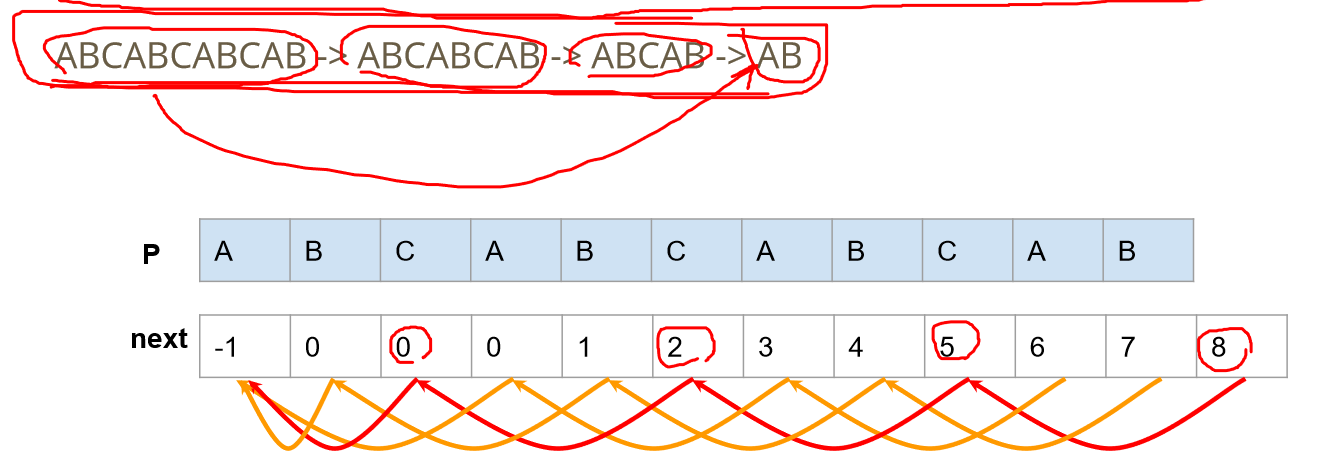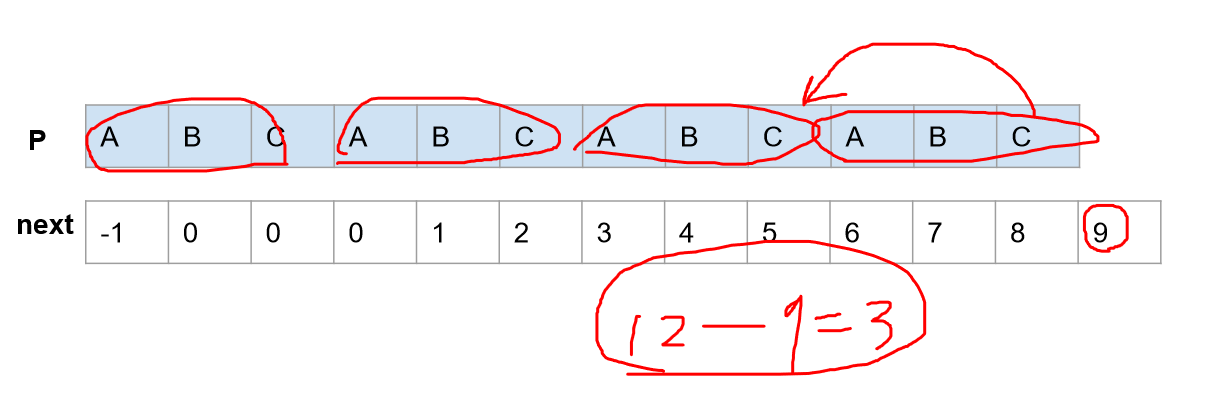KMP中next数组的理解与应用
理解
1、next数组一直往前走
next数组一直往前走,得到的所有前缀也是当前主串的后缀,当然了,也是当前主串的前缀。
2、周期性字符串
1、周期性字符串$\Leftrightarrow n \,\% \, (n-next[n]) == 0 \ \&\& \ next[n] {\ } {\!}!{=} \ 0 $,循环节长度是$n-next[n]$。

2、next数组往前跳的步长是一样的,除了最后一次。即$i-next[i]$保持恒定。

应用
- 题目一:Period
思路:先求出next数组,然后遍历一遍next数组得到所有字符结尾的字符串循环节的长度及个数
代码:

1 #include<cstdio> 2 #include<cstring> 3 #include<iostream> 4 using namespace std; 5 6 const int maxn = 1000000 + 10; 7 int nexts[maxn],n; 8 char s[maxn]; 9 10 void pre_kmp() 11 { 12 int i = 0, j = nexts[0] = -1; 13 while (i < n) 14 { 15 while (j != -1 && s[i] != s[j]) j = nexts[j]; //当前不匹配,j回退,寻找是否存在一个长度较小的字串和开头的字串相等 16 nexts[++i] = ++j; //j等于已匹配的长度,如果当前位置也匹配,则nexts直接为j+1 17 } 18 } 19 20 void slove() 21 { 22 pre_kmp(); 23 for(int i = 2; i <= n; i++) 24 if (i % (i - nexts[i]) == 0 && nexts[i] != 0) printf("%d %d\n", i, i / (i - nexts[i])); 25 } 26 27 int main() 28 { 29 int T = 0; 30 while (scanf("%d",&n) == 1 && n) 31 { 32 scanf("%s", s); 33 s[n] = '#'; 34 if (T) printf("\n"); 35 printf("Test case #%d\n", ++T); 36 slove(); 37 } 38 return 0; 39 }
- 题目二:Power Strings
思路:先求next数组,再直接求循环节
代码:

1 #include<cstdio> 2 #include<cstring> 3 #include<iostream> 4 using namespace std; 5 6 const int maxn = 1000000 + 10; 7 int nexts[maxn],n; 8 char s[maxn]; 9 10 void pre_kmp() 11 { 12 int i = 0, j = nexts[0] = -1; 13 //int n = strlen(s); 14 while (i < n) 15 { 16 while (j != -1 && s[i] != s[j]) j = nexts[j]; //当前不匹配,j回退,寻找是否存在一个长度较小的字串和开头的字串相等 17 nexts[++i] = ++j; //j等于已匹配的长度,如果当前位置也匹配,则nexts直接为j+1 18 } 19 } 20 21 void slove() 22 { 23 pre_kmp(); 24 if (n % (n - nexts[n]) != 0) printf("1\n"); 25 else printf("%d\n", n / (n - nexts[n])); 26 } 27 28 int main() 29 { 30 int T = 0; 31 while (scanf("%s", s) == 1 && s[0] != '.') 32 { 33 n = strlen(s); 34 s[n] = '#'; 35 slove(); 36 } 37 return 0; 38 }
- 题目三:Count The String
思路:求所有前缀出现的次数和,由于next数组回退得到的前缀也是主串的后缀,所以所有next回退的次数加上本身的一次取模就是答案。
代码:

1 #include<cstdio> 2 #include<cstring> 3 #include<iostream> 4 using namespace std; 5 6 const int mod = 10007; 7 const int maxn = 200000 + 10; 8 int nexts[maxn], n; 9 char s[maxn]; 10 11 void pre_kmp() 12 { 13 int i = 0, j = nexts[0] = -1; 14 //int n = strlen(s); 15 while (i < n) 16 { 17 while (j != -1 && s[i] != s[j]) j = nexts[j]; //当前不匹配,j回退,寻找是否存在一个长度较小的字串和开头的字串相等 18 nexts[++i] = ++j; //j等于已匹配的长度,如果当前位置也匹配,则nexts直接为j+1 19 } 20 } 21 22 void slove() 23 { 24 int ans = n; 25 pre_kmp(); 26 for (int i = n; i > 0; i--) 27 { 28 int k = nexts[i]; 29 while (k > 0) 30 { 31 ans = (ans + 1) % mod; 32 k = nexts[k]; 33 } 34 } 35 printf("%d\n", ans); 36 } 37 38 int main() 39 { 40 int T; 41 scanf("%d", &T); 42 while (T--) 43 { 44 scanf("%d", &n); 45 scanf("%s", s); 46 slove(); 47 } 48 return 0; 49 }
- 题目四:Cyclic Nacklace
思路:题目大意:问至少添加多少个字符,使得这个字符串有至少两个循环节。若本身有两个循环节返回0,否则补充至两个循环节。
代码:

1 #include<cstdio> 2 #include<cstring> 3 #include<iostream> 4 using namespace std; 5 6 const int mod = 10007; 7 const int maxn = 200000 + 10; 8 int nexts[maxn], n; 9 char s[maxn]; 10 11 void pre_kmp() 12 { 13 int i = 0, j = nexts[0] = -1; 14 n = strlen(s); 15 while (i < n) 16 { 17 while (j != -1 && s[i] != s[j]) j = nexts[j]; //当前不匹配,j回退,寻找是否存在一个长度较小的字串和开头的字串相等 18 nexts[++i] = ++j; //j等于已匹配的长度,如果当前位置也匹配,则nexts直接为j+1 19 } 20 } 21 22 void slove() 23 { 24 pre_kmp(); 25 int len = n - nexts[n]; 26 if (n % len == 0 && nexts[n] != 0) printf("0\n"); 27 else printf("%d\n", len - nexts[n] % len); 28 } 29 30 int main() 31 { 32 int T; 33 scanf("%d", &T); 34 while (T--) 35 { 36 scanf("%s", s); 37 slove(); 38 } 39 return 0; 40 }
参考链接:
1、https://vjudge.net/contest/278481#overview
2、https://blog.csdn.net/hkh746392783/article/details/52015293
个性签名:时间会解决一切


